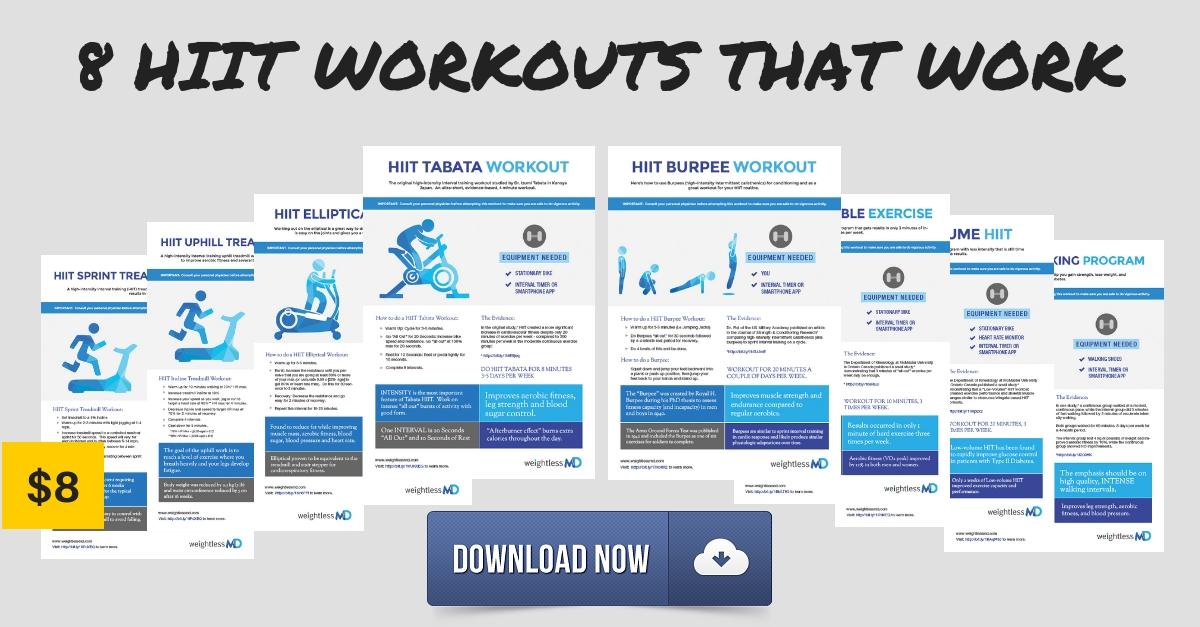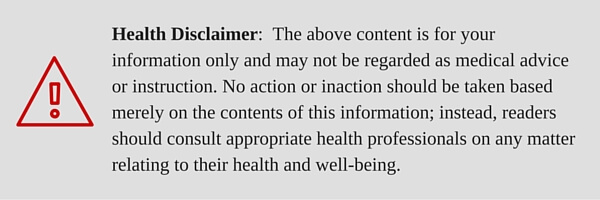I take care of hypertension all day long. This is my bread and butter. If only my patients would consider getting more exercise – many would be able to reduce or eliminate the need for blood pressure medications.
In fact, just this week I am attempting to get a patient off of his blood pressure medications.
He started running 5 days a week. He recently retired and found more time to devote to exercise again (along with other healthy habits).
His blood pressure normalized!
So, I took him off one blood pressure med and he had no problems.
His BP remained normal. So, we are trying to get hime off his last blood pressure medication – hydrochlorothiazide – which we’ll do with careful monitoring.
Now, don’t haul off and eliminate your blood pressure medications without talking to your doctor. That would be a disaster.
However, read on and consider working together with your personal physician to work on an exercise program (maybe utilizing HIIT) and eliminate a medication or two.
Studies have found that exercise is immensely beneficial for the blood pressure.
In fact, depending on the type of exercise you may be able to decrease your systolic blood pressure (the top number) by up to 10 mm Hg (range 2 mm Hg to 14 mm Hg) and the diastolic blood pressure (the bottom number) by up to 6 mm Hg (range from 2 mm Hg to 10 mm Hg) depending on the exercise.
Now, this is not as potent as medication, but nothing to scoff at.
Exercise is on par with and maybe superior to salt reduction in its ability to lower the blood pressure. A “modest” reduction of salt intake from about 9 grams to 4 grams per day can reduce systolic blood pressure by 4.18 mm Hg.
In fact, I suspect exercise may be more potent than suggested by the research. Studies are riddled with imperfect subjects – participants who do not adhere to the exercise or fail to complete the study. The data has a range of study participants – some that are responders and others that are not.
This does not eliminate the possibility that an individual who makes significant changes – much like my patient – could eliminate his need for medications.
Sadly, despite the proven benefits of exercise, most people have excuses.
The most common excuse is lack of time.
However, given the rise of high-intensity interval training (HIIT) people may just have to scrap the excuses.
As I have discussed previously, HIIT is bursts of activity (from 20 seconds to up to 4 minutes) with periods of rest for recovery.
HIIT benefits include weight loss, improved strength and aerobic fitness often in 1/2 the time of moderate continuous activity (such as a boring 30 minute jog).
The caveat is that you need to be intense. It’s all about the short bursts. The intensity builds up lactate, which may trigger adaptations in the muscle and heart that are beneficial and superior to moderate continuous activity.
These intense bursts may do magic on the blood vessel wall causing it to “loosen up” a bit and improve arterial stiffness to lower your blood pressure.
But we’ll get to that in just a bit.
So, could HIIT exercise help you to lower your blood pressure?
Fortunately studies have looked at this.
A study from Hypertension Research looked at healthy women with normal blood pressure, but who were at high risk for hypertension because of a strong family history.
Forty-four healthy females completed either a high-intensity interval training program or a moderate continuous walking program for 40 minutes 3 times per week for 16 weeks.
The high-intensity interval training consisted of 2 minutes of walking at moderate intensity (50-60% of VO2 Max) alternating with 1 minute of walking at high intensity (80-90% VO2 Max).
In addition, each group did 15 minutes of calisthenics.
Both the HIIT and moderate continuous exercise lowered blood pressures.
However, the HIIT group was superior in 3 ways:
- Improving cardiorespiratory fitness
- Improving the hormonal response to exercise
- Improving the nitric oxide response to exercise (a marker of “endothelial function”)
This suggests that HIIT may help the blood vessels relax, which may improve blood pressure.
In addition, only the HIIT participants showed improvements in carotid-femoral artery plus wave velocity (PWV).
What?
Agreed, that string of scientific terminology is hard to swallow. To simplify, the PWV is simply a way to measure the stiffness of the artery.
As we age, our arteries tend to stiffen, which leads to higher blood pressure.
Increased pressures in the arteries from aging and hypertension cause stress on the arterial walls leading to a breakdown of the lining of the wall (such as elastin and endothelial breakdown).
This process leads to atherosclerosis (literally “hardening or scarring of the arteries”).
A healthy artery has an immensely important thin layer of cells called the endothelium.
This layer is the innermost layer of cells in the blood vessel.
An important job of the endothelium is to stay smooth and toned to prevent turbulent blood flow.
Nitric oxide is a major chemical player in this function of the endothelium.
It turns out that HIIT (but not continuous exercise) in this study improves the function of the endothelium as well as arterial stiffness.
This is somewhat of the Holy Grail of atherosclerosis. Can we use exercises such as HIIT to turn back the clock and improve the stiffness of the artery?
This same group of researchers furthered this research by studying actual hypertensive patients (not just healthy, though high risk young females).
They took 65 patients for 16 weeks and compared HIIT versus continuous training. (They had a third group as well: “sedentary routine.”)
Once again the exercise groups lowered their blood pressures. No particular exercise was the winner.
Also again, only the HIIT group improved the arterial stiffness.
Arterial stiffness is another independent risk factor for heart disease and death. It appears that those who are more aerobically fit (based on VO2 max) are associated with less artery stiffness.
HIIT in particular has been found to potently improve aerobic fitness (VO2 max).
Another benefit to HIIT exercise.
How HIIT may improve the artery stiffness is a bit unknown. It may have something to do with the stress on the walls of the arteries during exercise. This shear stress may signal changes that improve the artery.
Does HIIT really lower the blood pressure effectively? The real answer is that we need more research.
These studies are intriguing and show that HIIT may improve arterial stiffness. This would be a big deal and could lead to better outcomes that we care about . . . such as less heart attacks, strokes and death.
Though, we would need larger studies over longer period of time to answer those questions appropriately.
How would you use this information to help lower your blood pressure?
Decreasing the systolic blood pressure by a mere 2 mm Hg has been found to decrease the risk of death from stroke by 10% and the risk of death by heart attack by 7%.
This can be easily accomplished by exercise. The particular type of exercise is a matter of some debate, but you should consider HIIT based on this research.
To increase the chances you’ll stick to it, you should really do just any exercise you enjoy. Though I have discussed in the past how HIIT is at least as enjoyable as other exercise and maybe more.
So, you may want to consider it.
If you are a HIIT believer, you could incorporate HIIT into your routine just like the research.
Here is how to do HIIT on a treadmill to lower your blood pressure (based on the research).
For 3 days per week on a treadmill:
- 5 minutes of warm up.
- 2 minutes of moderate pace walking at about 1/2 your max and alternate with a 1 minute burst of 80-90% max (such as 80-90% of your heart rate max [220-age]).
- Alternate the high and moderate intensities for 40 minutes.
- Finish it off with 15 minutes of “calisthenics” such as jumping jacks, push ups, lunges, sit-ups, pull-ups, Burpees, squats . . . etc. The study does not really describe this, so you are on your own with the calisthenics.
Related:
- HIIT for Weight Loss: The Science Explained
- HIIT for your Heart
- Another Benefit of HIIT: Appetite Suppression
- 4-minute Tabata HIIT Workout
- Burpee Workout for High-Intensity Interval Training (HIIT)
- An Interval Walking Program: To lose weight, get strong and beat diabetes
How to determine if you need to see a physician before starting an exercise program from the American College of Sports Medicine: When to see a Physician Before Exercising
The Evidence:
- Ciolac, et al. Effects of high-intensity aerobic interval training vs. moderate exercise on hemodynamic, metabolic and neuro-humoral abnormalities of young normotensive women at high familial risk for hypertension. Hypertension Research, 2010.
- Guimarães, et al. Effects of continuous vs. interval exercise training on blood pressure and arterial stiffness in treated hypertension. Hypertension Research, 2010.
- Vaitkevicius, et al. Effects of age and aerobic capacity on arterial stiffness in healthy adults. Circulation, 1993.
- Cornelissen, et al. Exercise Training for Blood Pressure: A Systematic Review and Meta‐analysis. Journal of the American Heart Association, 2013.
Image Credit: Image from page 143 of “Principles of electro-medicine, electrosurgery and radiology : a practical treatise for students and practitioners. With chapters on mechanical vibration and blood pressure technique” (1917) on Flickr


